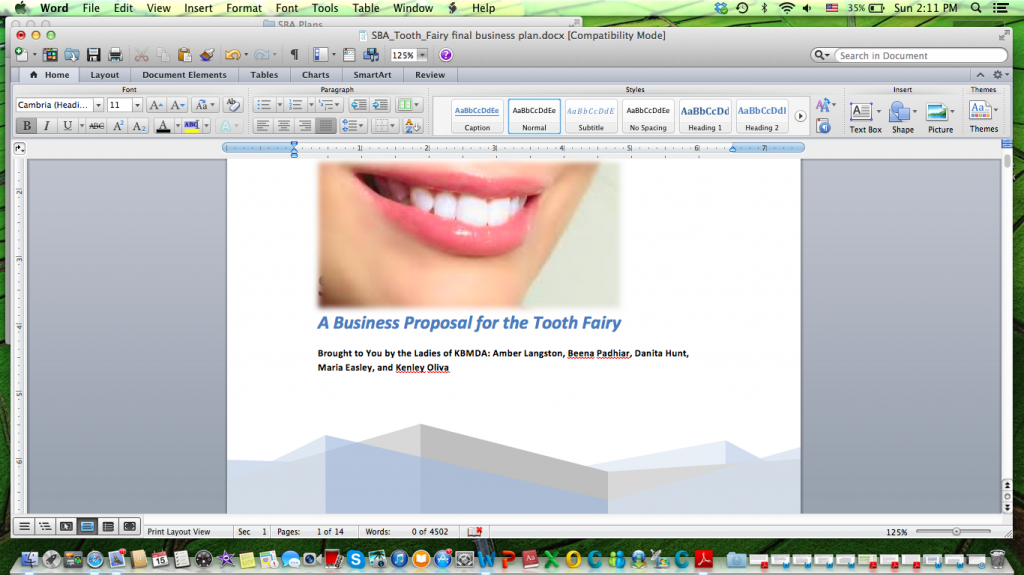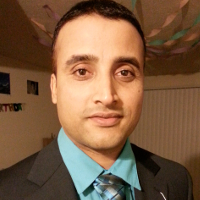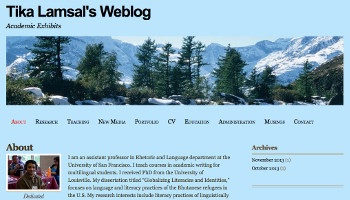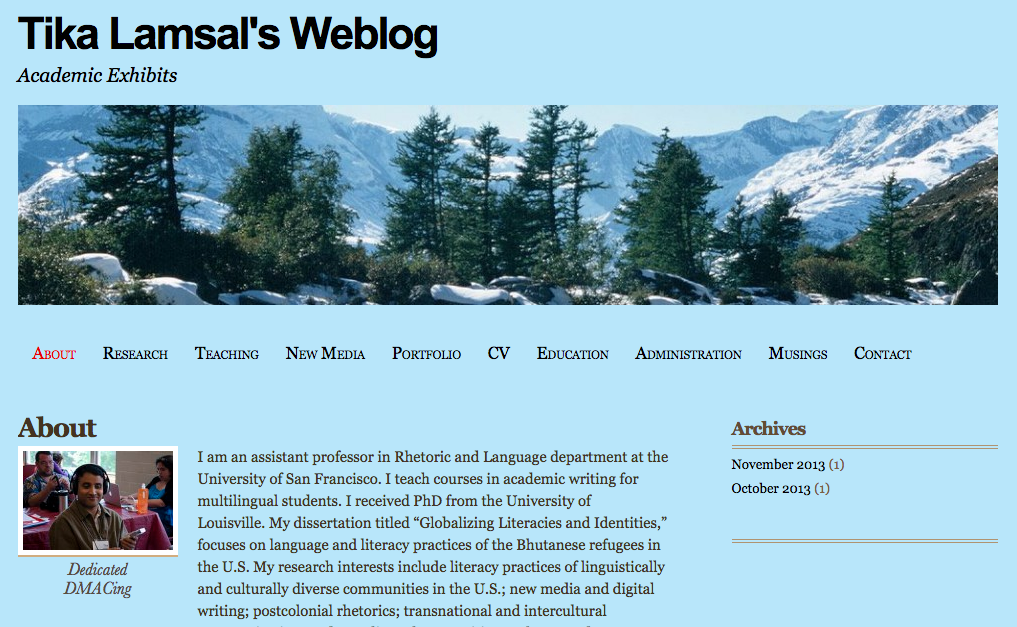Tika Lamsal
Introduction
Video Introduction (click the CC button for captions)
click here to download a transcript of this video
In recent decades, digital and new media technologies have been used widely for the purpose of reading, writing, and teaching. The use of technological tools for teaching, however, generally means using mostly audio-visuals. I will examine this assumption by demonstrating how technology has also changed the nature of teaching writing (of the alphabetic sort) and how web technology mediates writing. Considering student composition in school classrooms and their use of digital technologies for community practices as discrete leads to an understanding of modes (e.g., visuals) as autonomous. Rather than understanding the fluid, changing nature of digital writing, with autonomous models we emphasize modalities as discrete practices.
Based on my academic background in Nepal, I understood modality as autonomous because writing meant producing alphabetic text in a print form. Such an attitude was mostly informed by the assumption that multimodality primarily belonged to other disciplines such as communication and information technology. Such ideology was an outgrowth of an autonomous model of literacy that considered reading and writing across print forms as standard features to define literacy practices, limiting reading and writing practices to what is verbalized and printed. Other literate modes of learning such as the aural and visual often were excluded beyond the domain of literacy.
Brian Street develops a sociocultural model of literacy by analyzing the assumed difference between autonomous and ideological models to demonstrate how the autonomous model is, in fact, deeply ideological. The former, according to Street, tends “implicitly to privilege and to generalize the writer’s own conceptions and practices, as though these were what ‘literacy’ is.” Such an etic approach to literacy stands in sharp contrast to an ideological model, which takes into account “the specific social practices of reading and writing” (2). Access to and use of technology cannot exceed such social practices of learning, so a student’s use of technology for the purpose of academic writing should be examined in terms of such practices.
The way I was groomed to write with pen and paper when I was a college student in Nepal in the 1990s was in itself a social practice of learning that included not a singular mode of writing but multiple features that were visually and aurally implicated in the composition process. I developed computer skills for writing much later when I completed my Master’s degree and started teaching at a state university in Nepal in 1998. So, to me, use of pen and paper itself was a mode of technology, although the writing process with those tools embodied an entirely different mode than that represented by computer skills. In his discussion of the ideological model of literacy, Street challenges the assumption that the autonomous model of literacy is a technical, objective, neutral, and cognitive entity (in short, not ideological), and he analyzes the contradictions and problems this assumption leads to.
Moreover, we must consider access to these modes before looking at how certain writers use technology. Technology perhaps inadvertently serves only the people who can afford to use computers and other technological resources, and we forget that it helps certain people and marginalizes others. Therefore, an autonomous model shapes our understanding of technology and writing without acknowledging that it is ideological and supports only the select few. Currently, aural and visual modes have become even more dominant modes of communication; moreover, writing itself is visual, and modes in themselves are shaped by historical, social, cultural changes. In practice, we need to see the use of technology in writing through an ideological model. We also need to acknowledge that practice is messy, so to evaluate writing practices only through an autonomous model risks generalizing print-based text as “writing” in its entirety.

Transitioning across Multiple Academic Spaces
When I was still a college student in Nepal technology was hardly a thing of teaching and writing; the educational environment was characterized more by paucity of resources just for basic teaching materials, let alone the use of computer technologies. Teachers mostly used the textbook for teaching and learning, which inculcated in students similar lecturing practices rather than interactive and multimodal forms. Writing similarly was only something we did during the exams at the end of the academic year, and that was an all-handwritten test. Although we experienced a physical connection with our concepts in handwritten responses, it was still a print form of literacy. When I started to use technology, especially audio-visuals, for teaching when I was still in Nepal, I did it as an autonomous activity by assuming that it was a mode of teaching absolute in itself, needing no substantiation for the teaching of English and writing. Later, when I taught mostly English literature and rhetoric courses, technology percolated in the form of Internet resources, just for finding reading materials and online resources for class preparation. PowerPoint was an occasional luxury for special presentations during literary conferences and invited talks.
However, as I started to teach as a GTA for a U.S. university, I saw a change in material conditions, affordance, and access, but not much in the way that technology was used with respect to modal autonomy. Due to my deep interest in teaching with technology, I felt empowered and equipped with computer technology and other digital resources as soon as I started to teach first-year writing in the U.S. in 2008. Despite the easier affordances and access to technology, though, I still used it as a discrete mode of teaching and learning, a resource complete in itself. I saw technology as more of a teaching tool than a complement to teaching practices. I still used computer technology such as YouTube and Google Scholar in the same way that I used it in Nepal: as a mode of teaching without much attention to the ideological nature of its usage.
Hands-on practice with new software and tools for teaching and learning at the DMAC workshop allowed a better theoretical understanding of those practices in ideological terms. As I thought seriously about technological literacy, I became more aware that beyond technological aspects of reading and writing practices, agendas of technology support “social divisions along race, class, and gender and keep[s] us from fully understanding the complexities of literacy values and practices and from defining literacy instruction in ways that could help address some of these problems” (Selfe xxi). This understanding helped me foster better teaching strategies and develop more effective ethnographic research methods when working on multimodal and multilingual literacies in Bhutanese refugee communities.
Learning about Multimodal Research
During the 2012 DMAC Institute, I became more aware of critical technological literacy and its impact on teaching and learning practices, especially for international students and scholars like me. Critical technological literacy, as Selfe suggests, moves beyond academic or theoretical discussions to entail participants’ community activism and the change they bring for the benefit of community people. In my research on literacy practices of Bhutanese refugee communities in the U.S., I examined young people’s critical technological literacy practices to explore how multimodal and multilingual activities in the community became resources for active participation on similar academic activities in schools. This research among the communities’ youth further helped me to pay more attention to the needs of students in the classroom and to see how their desires reflect in their learning process.
Mother’s Day video created by a Bhutanese refugee youth in Louisville, Kentucky
click here to download a transcript of this video
Resham, one of the Bhutanese refugee participants in my study, produced this video for the occasion of Mother’s Day according to the Nepali calendar, using real mother-son characters for the performance. He wanted to raise awareness of cultural and family values among Bhutanese communities by reproducing the cultural event in a new form in the diaspora. Giving literacy events new form through multimodal production, these youth participated in the production and circulation of knowledge, giving new forms to existing literacy practices which otherwise would remain unrecognized as such. I was also interested in why they used English captions for conversations in Nepali. Resham said that using English captions allowed him to communicate across cultures and forge family relations in a diaspora. Other communities could understand how highly family relations are valued in Bhutanese refugee communities.
This kind of multimodal production, as Resham pointed out during our interview, also increases interracial interaction as people from other cultures share and add to multilingual and cross-cultural discourse across digital space. The interface between community culture and language values through online networking and multimodal designs (a) facilitates social language development; (b) opens new diasporic landscapes for expanding connections; and (c) promotes cross-cultural and multilingual practices for effectively managing transcultural relationships in an increasingly globalized and digitized world (Canagarajah; Jayakumar). Such textual designs through new media help the community members promote cross-cultural and cross-language practices as inevitable aspects of learning. Images and sonic effects, once considered subservient to written language, now comprise layering capabilities for designing video texts that display the inextricable relationships among modalities such as language, images, and sound (New London Group; Cope and Kalantzis; Jewitt).
My participation at DMAC enabled me to use such modailities as resources for field work and data collection among the Bhutanese refugee community in Louisville. As a result of my participation, I could critically examine the ideological nature of technology in the refugees’ lives, as well as how technology afforded them ways to create video projects that assert their identity and agency and that produce and circulate knowledge in their community.
Hands-on Learning Opportunities at the Workshop
Where Home Doesn’t Belong, by Santosh Khadka and Tika Lamsal
click here to download a transcript of this video
During DMAC I began this dissertation project by creating a multimodal video (in collaboration with Santosh Khadka), which represented life stories of Bhutanese refugees across several locations of their migration. Entitled “Where Home Doesn’t Belong,” this video text weaves several threads of narratives using images, sounds, and visual rhetorical designs to depict the struggle of Bhutanese refugees in the U.S. in terms of political, economic, cultural, and language issues during their adjustment process. Juxtapositions, transitions, and layering of multiple texts in this project helped me better understand the unruly nature of composing in multimodal form that embedded within it a powerful meaning about people’s experiences, feelings of loss, and their struggle with poor living conditions in various places that they inhabited.
When playing with images, letters, pictures, sound tracks, and other aural and visual media I found that the process of making meaning became more effective and rich as I composed with modalities beyond printed text. Arranging and ordering were critical in the revised versions of this project. In addition to the symbiotic relationship between the textual, aural, and visual layers, a recurring musical track establishes pathos with representations of the refugees’ suffering as non-citizens in both their country of origin and their country of resettlement. For example, the image of a dolphin convulsing out of the water suggests the refugees’ feelings of uprootedness and suffering incurred upon them by their own state. People extending their hands to help the dolphin stand for the outside world that has extended helping hands to the refugees during their bad times. The images of fire and ceremony toward the end of the video communicate the refugees’ resilience and strong voice for justice.
Classroom Teaching
DMAC also allowed me to develop a clear, critical perspective on ideological issues of teaching with technology, which has enabled emergent and fluid modes of learning with mobile phones, Internet facilities, tablets, and, of course, computers. DMAC participation reinforced my belief that digital literacies have added a new layer of complexity to perceptions of linguistic and cultural differences. Social networks such as YouTube and Facebook allow students to transform their literate practices in U.S. schools and communities. During DMAC, questions surfaced and became very pertinent to our current concerns about the literacy practices of minority language speakers such as refugees and immigrant students. Why should we pay attention to all of the different media and modalities for composing meaning that students are calling to our attention? What responsibilities do we have to teach conventional academic writing, and what responsibilities do we have to teach other modalities of composing? Are university faculty—grounded by their education in the environment of print—prepared to work productively with people who prefer to work with other technologies?
Since DMAC, my teaching practices have reflected these concerns. In first year writing courses, I integrated ethnographic and multimodal features in the assignments. For example, in one first-year writing class, three students produced a multimodal project that analyzes the language patterns of an immigrant family from South Asia. The students visited this family throughout the semester, interviewed four of the family members, and created an audio essay to explore how this family’s learning of English in the U.S. was affected by multilingual and civic contexts. Building rhetorical knowledge in a variety of modes, sites, and genres of language use, the students used rhetorical and communication designs to explore the complex interactions within their social and cultural contexts. Similarly, in a business writing class (which I designed and named “Business Incubation”) a student group produced a small business administration plan by analyzing the business and marketing patterns of a local community. Working as a project team, the students designed a survey, interviewed three business people in the community, and proposed a start-up business on comprehensive oral health, KBMDA (Killing Bad Mouth Disease Altogether).

In both courses, students built rhetorical knowledge with a variety of modes, sites, and genres of language use, and they used communication designs to explore the complex interactions within their social and cultural contexts.
Professionalization Opportunities
I developed a professional website during my participation in the 2012 DMAC Institute. This website showcases my academic and scholarly achievements in detail through various modes of writing. I designed the visual interface with a particular rhetorical symmetry to include representative information about my professional life, and this process made me more aware of the power of multimodal writing.
As shown in the site’s default page, my purpose in designing this interface was to help readers understand the message by simply viewing the outer layers along with the major headings surrounding the image of the mountains. I also organized the stages of my professional development across visual modes under various headings and sub-headings and provided further explanation on consecutive pages. The overall design and visual representation of academic stages showcase my academic exhibits in a more organized and professional way.
Conclusion
In this essay, I have explored, based on my own experiences of participating at the 2012 Digital Media and Composition Institute, how DMAC contributes to our understanding of technology for rhetorical designs in writing, research, and professionalization. My commitment to teaching with digital media, conducting research in the field, and developing a professional archive online was furthered by my participation as I practiced hands-on skills with rhetorical design, video editing, and the use of writing software for teaching.
Drawing on my own experiences as an international student and teacher, and also on the ideological model of literacy developed by Brian Street, in this reflective essay I have demonstrated how teacher’s attitudes toward technology can change by driving away the fear of using technology for writing that perches deep in the minds of people who begin to use technology for teaching and writing purposes. This fear is more dominant in the minds of international GTAs and scholars because of an academic background that may consider writing in print as default. DMAC, through its robust teaching and research strategies, fostered newer and more convincing perspectives to enhance my teaching, research, and professional skills.
Works Cited
Canagarajah, A. Suresh. “Negotiating the Local in English as a Lingua Franca.” Annual Review of Applied Linguistics 26 (2006): 197-218. Print.
Cope, Bill and Mary Kalantzis (Eds). Multiliteracies: Literacy Learning and the Design of Social Futures. London and New York: Routledge, 2000. Print.
Jayakumar, Uma M. “Can Higher Education Meet the Needs of an Increasingly Diverse and Global Society? Campus Diversity and Cross-Cultural Workforce Competencies.” Harvard Educational Review 78.4 (2008): 615-651. Print.
Jewitt, Carey. “Multimodality and Literacy in School Classrooms.” Review of Research in Education 32.1 (2008): 241-267. Print.
New London Group “A Pedagogy of Multiliteracies: Designing Social Futures.” Harvard Education Review 66.1 (1996): 60-92. Print.
Selfe, Cynthia Technology and Literacy in the 21st Century: The Importance of Paying Attention. Carbondale, IL: Southern Illinois University Press, 1999. Print.
Street, Brian. Literacy in Theory and Practice. Cambridge: Cambridge University Press, 1984. Print.
Author
 Tika Lamsal teaches at the Department of Rhetoric and Language at the University of San Francisco. His research interests include multilingual and multimodal literacies, second language writing, non-western rhetorics, and South Asian diaspora writing. His dissertation at the University of Louisville shows how immigrant refugees negotiate their ways to academic, cultural, and economic success in the U.S. by using linguistic, cultural, and multimodal resources in new contexts.
Tika Lamsal teaches at the Department of Rhetoric and Language at the University of San Francisco. His research interests include multilingual and multimodal literacies, second language writing, non-western rhetorics, and South Asian diaspora writing. His dissertation at the University of Louisville shows how immigrant refugees negotiate their ways to academic, cultural, and economic success in the U.S. by using linguistic, cultural, and multimodal resources in new contexts.

